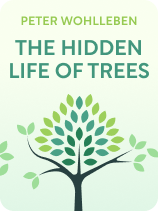

This article is an excerpt from the Shortform book guide to "The Hidden Life of Trees" by Peter Wohlleben. Shortform has the world's best summaries and analyses of books you should be reading.
Like this article? Sign up for a free trial here.
Are trees sentient? How does their sentience compare to human consciousness? In what ways do trees have personalities?
Peter Wohlleben, forester and author of The Hidden Life of Trees, claims that he has evidence that trees are sentient. Wohlleben says trees can learn, they have a sense of time, and they have distinct personalities.
Let’s dive further into each piece of evidence.
Trees Are Sentient—In Their Own Way
Are trees sentient? In his book, Wohlleben proposes the idea that trees are, in fact, sentient. While Wohlleben doesn’t claim trees have consciousness or emotions in the way humans do, he suggests that they exhibit behaviors and responses that indicate a level of sensitivity to and awareness of their surroundings which could be described as sentience.
According to Wohlleben, trees’ root systems have similarities with the human brain. He explains how roots, much like our neurons, transmit signals and share information, forming a sophisticated communication network. This unseen tree “brain” isn’t centralized as it is in humans, but spread out below ground, with each root tip acting like a mini control center. This root tip allows trees to detect water, absorb nutrients, and even interact with neighboring trees, sharing resources and sending distress signals.
(Shortform note: Simard (Finding the Mother Tree) elaborates on the similarities between this underground network and the human brain in a 2021 interview. She explains that the underground network of roots and fungi closely resembles a human’s neural network, as both are systems designed for the most efficient transfer of information and resources. Furthermore, one of the chemicals found in trees’ networks is glutamate, a primary brain neurotransmitter in humans. Like Wohlleben, Simard argues that based on her observations of trees’ sophisticated interactions, she can only conclude that they hold a kind of wisdom.)
Wohlleben offers three additional pieces of evidence to support his argument that trees are sentient:
- Trees are capable of learning.
- Trees have a sense of time.
- Trees have distinct personalities.
In the next section, we’ll discuss each piece of evidence in greater depth.
1. Trees Are Capable of Learning
First, Wohlleben argues that trees are capable of learning based on their ability to adapt to changing environmental conditions. For example, trees that have survived intense droughts store more water in the subsequent years, indicating a type of memory and ability to learn from previous hardships. Wohlleben also notes how trees in crowded forests moderate their growth rates to avoid overshadowing nearby trees, illustrating a sense of spatial awareness and knowledge of their surroundings.
(Shortform note: Further research suggests that trees aren’t only capable of adapting to their environment, but they can also make decisions about how to adapt. A 2017 study found that plants respond differently to competition for light depending on their environment. The experiment showed that plants grew taller if surrounded by similarly sized, dense neighbors, exhibited greater shade tolerance when surrounded by taller, denser neighbors, and grew wider when surrounded by taller, sparser neighbors. These findings suggest that plants can tailor their growth according to both current circumstances and probable future ones.)
2. Trees Have a Sense of Time
Wohlleben also argues trees have a sense of time rooted in their innate biological rhythms and cycles. He points out that trees follow a yearly cycle of growth and dormancy that aligns with the changing seasons, suggesting they have an internal clock that guides their activities. For instance, trees know when to sprout and drop their seeds to ensure the maximum chance of survival. Trees of the same species even produce seeds at the same time to ensure the genes of individual trees are well-mixed. Similarly, trees know when to shed their leaves in the fall to conserve resources for the winter, and when to resume growth in the spring when resources are abundant.
(Shortform note: In Braiding Sweetgrass, Kimmerer expands on trees’ collective sense of time using the example of pecan trees’ mast fruiting. Kimmerer explains how all pecan trees in a region time their seed production collectively. The oversupply of nuts causes a surge in the squirrel population, which triggers an influx of predators, causing a subsequent decline in the squirrel numbers. The pecan trees then begin producing seeds again, strategically timed when squirrel numbers are low, increasing their seeds’ chances of germination. Kimmerer’s analysis of pecan trees’ synchronized masting behavior shows how the biological clock of trees influences not only their personal growth cycles but also broader, communal survival strategies.)
3. Trees Have Distinct Personalities
Finally, making his case for tree sentience, Wohlleben also argues that trees, like humans or other animals, have distinct personalities. He observes that individual trees, even when growing in the same soil and under the same microclimate, sometimes change color and shed their leaves at different times. This variation, he suggests, isn’t merely a response to environmental factors, but a matter of individual choice, suggesting a unique character or personality.
(Shortform note: J.R.R. Tolkien’s portrayal of Ents—the ancient tree creatures in The Lord of the Rings trilogy—provides a striking fictional echo to Wohlleben’s views on tree sentience and individuality. In Tolkien’s world, Ents aren’t simply animated trees but beings with personalities, wisdom, and complex emotions. While Ents only exist in the realm of fantasy, they serve to highlight a perspective that Wohlleben encourages his readers to consider—that trees are more than just interchangeable lifeforms; they carry an essence of personality and individuality.)
Similarly, says Wohlleben, while it is generally more advantageous for trees to invest energy into branches at their crown, where they can absorb more sunlight, not all trees follow this strategy. In a forest clearing, for instance, some trees choose to sprout new branches on their trunk, while others don’t. Wohlleben interprets this as another sign of individual choice or character, further supporting his argument that trees exhibit a form of sentience.
(Shortform note: While Wohlleben interprets trees’ different growth patterns as evidence of individual choice, other scientists argue these differences are simply innate adaptations that maximize survival in different ecological settings. For example, a tree in a forest clearing may sprout branches on its trunk because it receives more sunlight due to the break in canopy cover. It could also be a response to competition from other flora. When faced with heavy undergrowth, trees need to optimize their leaf surface area for maximum photosynthesis. This means the existence of distinct personalities isn’t the only possible explanation for Wohlleben’s observations.)
Why Does the Complexity of Trees Matter?
According to Wohllben, trees’ ability to cooperate, communicate, and respond to their environment in ways that resemble intelligence should compel us to re-evaluate our perception of forests. First, there are practical implications for how we manage forests. For example, if trees are interdependent and communicate, then the felling of one tree isn’t simply the removal of an individual, but a disturbance to a community. Furthermore, acknowledging trees’ sentience could pivot forestry practices toward more sustainable logging, land usage, and conservation efforts that respect and prioritize the well-being of trees and forests.
Beyond the pragmatic, Wohlleben’s ideas extend into the philosophical realm, encouraging us to broaden our understanding of community and cooperation beyond the confines of the human and animal spheres. This perspective invites a rethinking of our relationship with nature and our roles as environmental stewards and promotes a heightened respect for the lives of trees.
| What Do Critics Say About Wohlleben’s Ideas? Wohlleben is explicit that his goal in writing The Hidden Life of Trees was to get people to think differently about the innate value of trees. However, many in the scientific community, including ecologists and tree physiologists, take issue with Wohlleben’s approach. Critics of Wohlleben pinpoint several issues with the book. First, many object to Wohlleben’s anthropomorphization of trees. Even Simard, whom Wohlleben cites repeatedly, is quoted as saying that his anthropomorphization was “too much.” Additionally, some argue that Wohlleben cherry-picks scientific evidence to support his views, disregarding conflicting research that doesn’t align with his narrative. For example, Wohlleben’s portrayal of forests as cooperative and interconnected ignores the fierce competition that also exists within ecosystems. However, in his review of The Hidden Life of Trees, New Yorker writer Robert Moor suggests that the soft science underpinning the book matters less than the book’s impact. He makes the case that Wohlleben has brought much-needed attention to a previously neglected issue and that this perhaps justifies the parts of the book that read more like fiction than science. |

———End of Preview———
Like what you just read? Read the rest of the world's best book summary and analysis of Peter Wohlleben's "The Hidden Life of Trees" at Shortform.
Here's what you'll find in our full The Hidden Life of Trees summary:
- The characteristics of trees and forests that make them so remarkable
- How trees in old-growth forests cooperate and communicate
- Actionables that humans can take to help protect the forests







Peter Wohlleden is right – trees ARE sentient beings. I lived in coastal northern California for a few years. One early afternoon I was driving from Skyline Boulevard north and west of Menlo Park to visit the beach. I came upon a curve in the road leading to the beach and there were redwoods cut and strewn on both side of the road. A couple was walking nearby and I asked them what was the reason? They said the County was re-routing the road between Skyline and the beach. The couple walked on but I heard, out loud, a strong voice asking “Why do they want to kill us?” I looked around, no one else was there, but the voice was insistent and repeated the question. Because this was so real, I responded out loud, repeating what the couple had told me. The voice then countered loudly and with deep hurt: “But we did nothing wrong, we live here, this is our home, we did nothing wrong…” I felt an instant bond with this voice whom I now believe to be one of the redwoods, a truly sentient being. I told the voice I would look into this with the County. The next day I met with the planning commission for this project and helped them find a better, easier and less costly to the tax payers, which did not involve clearing out more redwoods. A week later, on the next weekend, I returned to the place where the voice had first spoken to me. I parked my car and walked into the forest. Immediately the voice, joined with others, spoke to me, thanking me for intervening for them to protect them and stop any further destruction of the forest. I replied it felt like the right thing to do so all parties and shared no further damage to the forest would be done. The voices thanks me over and over and over with great joy and relief in their voices, and we became friends. I was welcomed into their “community” and accepted as a member of the coastal redwood family, and am blessed to remain so to this day, and when I visit there it is truly like a special, spiritual kind of homecoming for them and for me – we remain one and I am truly humbled. Whenever I travel further northward along the California Coast Highway and walk among the redwood giants I am embraced by them with their words of recognition, thanks, and comfort so evidently the ones I originally helped to protect have intimate connections to other redwood families….yes, they truly are sentient beings, and in my opinion and my experience, often far more sentient than many of the humans I have met in their interactions with fellow humans… Dr. James Bowman, Stevens Point, Wisconsin USA